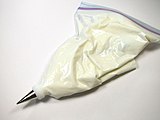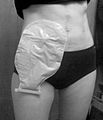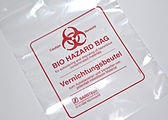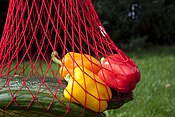Rsrikanth05 (
talk |
contribs) Reverted 2
good faith edits by
117.207.12.34 using
STiki |
No edit summary |
||
| Line 2: | Line 2: | ||
[[File:Bagging vegetables.jpg|thumb|300px|Bags used to help keep vegetables clean and fresh]] |
[[File:Bagging vegetables.jpg|thumb|300px|Bags used to help keep vegetables clean and fresh]] |
||
A '''plastic bag''', '''polybag''', or '''pouch''' is a type of [[packaging]] made of thin, flexible, [[plastic film]], [[nonwoven fabric]], or plastic [[textile]]. Plastic bags are used for containing and transporting goods such as foods, |
A '''plastic bag''', '''polybag''', or '''pouch''' is a type of [[packaging]] made of thin, flexible, [[plastic film]], [[nonwoven fabric]], or plastic [[textile]]. Plastic bags are used for containing and transporting goods such as foods, sexy, powders, ice, magazines, chemicals and waste. |
||
Most plastic bags are heat sealed together. Some are bonded with adhesives or are stitched. |
Most plastic bags are heat sealed together. Some are bonded with adhesives or are stitched. |
||
Revision as of 17:46, 24 October 2014

A plastic bag, polybag, or pouch is a type of packaging made of thin, flexible, plastic film, nonwoven fabric, or plastic textile. Plastic bags are used for containing and transporting goods such as foods, sexy, powders, ice, magazines, chemicals and waste.
Most plastic bags are heat sealed together. Some are bonded with adhesives or are stitched.
Bags
Packages
Several design options and features are available. Some bags have gussets to allow a higher volume of contents. Some have the ability to stand up on a shelf or a refrigerator. Some have easy-opening or reclosable options. Handles are cut into or added onto some.
Plastic bags usually use less material than comparable boxes, cartons, or jars, thus are often considered as "reduced or minimized packaging". [1]
Depending on the construction, plastic bags can be well suited for plastic recycling. They can be incinerated in appropriate facilities for waste-to-energy conversion. They are stable and benign in sanitary landfills. [2] If disposed of improperly, however, plastic bags can create unsightly litter and harm some types of wildlife. [3] [4]
Bags are also made with carrying handles, hanging holes, tape attachments, security features, etc. Some bags have provisions for easy and controlled opening. Reclosable features, including press-to-seal zipper strips such as Ziploc, are common for kitchen bags bought empty and for some foods. Some bags are sealed for tamper-evident capability, including some where the press-to-reseal feature becomes accessible only when a perforated outer seal is torn away.
Bags can be made with a variety of plastics films. Polyethylene ( LDPE, LLDPE etc.) is the most common. Other forms, including laminates and coextrusions can be used when the physical properties are needed.
Boil-in-bags are often used for sealed frozen foods, sometimes complete entrees. The bags are usually tough heat-sealed nylon or polyester to withstand the temperatures of boiling water. Some bags are porous or perforated to allow the hot water to contact the food: rice, noodles, etc.
Bag-in-box packaging is often used for liquids such as wine and institutional sizes of other liquids.
Plastic shopping bags
Open bags with carrying handles are used in large numbers nationwide. Stores often provide them as a convenience to shoppers. Some stores charge a nominal fee for a bag. Heavy-duty reusable shopping bags are often considered environmentally better than single-use paper or plastic shopping bags.
Because of environmental and litter problems, some locations are working toward a phase-out of lightweight plastic bags.
Waste disposal bags
Flexible intermediate bulk container
Flexible Intermediate Bulk Containers (Big bags, bulk bags, etc.) are large industrial containers, usually used for powders or flowables.
Use of plastic bags internationally
The number of plastic bags used worldwide has been estimated to be on the order of 1 trillion annually. [5] The use of plastic bags differs dramatically across countries. While the average consumer in China uses only 2 or 3 plastic bags a year, the numbers are much higher in most other countries: Denmark: 4, Ireland: 18, Germany: 65, USA: > 300, Poland, Hungary, Slovakia: more than 400. [6] In order to reduce plastic bag consumption, the European Union has suggested to pass new regulations. [6]
Danger to children
Thin plastic bags, especially dry cleaning bags, have the potential for causing suffocation. About 25 children in the United States suffocate each year due to plastic bags, 99.2% are under the age of one. [7] This has led to voluntary warning labels on some bags which may pose a hazard to small children. [8]
Environmental damage
Non-compostable plastic bags can take centuries to decompose. In the 2000s, many stores and companies began to use different types of biodegradable bags to comply with perceived environmental benefits. [9] [10]
Plastic shopping bags which escape the garbage collection process can end up in streams, which then lead them to end up in the open ocean. The way in which the bags float in open water can resemble a jellyfish, posing significant dangers to marine mammals and Leatherback sea turtles, when they are eaten by mistake and enter the animals' digestive tracts.
A large number of cities and counties throughout the United States, and elsewhere in the world, have banned the use of plastic bags by grocery stores. In September 2014, California became the first state to pass a law banning their use. Local manufacturers of plastic bags, under the legislation, would receive financial support to assist them make more durable multi-use bags, that would be sold by grocery stores rather than given away, as were the plastic bags.<
Gallery
Plastic bags are used for diverse applications:
-
Snack chips
-
Gardening supplies
-
blood platelets
-
inner bladder for bag-in-box
-
Pastry bag with convenience closure
-
Biohazard bag
-
Bin bag or trash bag
-
String bag made of plastic fibers
-
Multiple chambers for eventual mixing
-
Porous bag for cooking rice
-
Intravenous therapy
See also
- Bioplastic
- Biodegradable polythene film
- Biodegradable bags
- Biodegradation
- Box wine
- Litter
- Milk bag
- Phase-out of lightweight plastic bags
- Photodegradation
- Plastic recycling
- Refuse-derived fuel
- Ziploc
- Zipper storage bag
Notes
- ^ Franklin (April 2004). "Life Cycle Inventory of Packaging Options for Shipment of Retail Mail-Order Soft Goods" (PDF). Retrieved December 15, 2008. In June 2009 Germany’s Institute for Energy and Environmental Research concluded that oil-based plastics, especially if recycled, have a better Life-cycle Analysis than compostable plastics. They added that "The current bags made from bioplastics have less favourable environmental impact profiles than the other materials examined" and that this is due to the process of raw-material production.
- ^ Lapidos, Juliet (2007-06-27). "Slate Explainer, 27 June 2007". Slate.com. Retrieved 2010-07-07.
- ^ "Teresa Platt Commentary, Plastic Bags on Our Backs, May 2008". teresaplatt.com. Retrieved 2010-07-07.
- ^ Mieszkowski, Katharine (August 10, 2007). "Plastic bags are killing us". Salon.com. Retrieved April 23, 2013.
- ^ Plastic bag statistics
- ^ a b EU will Plastiktüten-Verbrauch begrenzen, Zeit Online, 4 Nov. 2013
- ^ http://www.cpsc.gov/CPSCPUB/PUBS/5064.pdf
- ^ "Consumer Product Safety Commission". Cpsc.gov. Retrieved 2010-07-07.
- ^ Wilder, Sam. "Festival food recycling: Sun, fun and diversion." BioCycle 47.6 (June 2006): 30(3).
- ^ "The supermarket chain Aldi Süd of Germany is now offering its customers shopping bags made of BASF's biodegradable plastic Ecovio. (Industry News and Notes, brief article)." Plastics Engineering 65.6 (June 2009): 54(2)
References
- Yam, K. L., "Encyclopedia of Packaging Technology", John Wiley & Sons, 2009, ISBN 978-0-470-08704-6
- Soroka, W, "Fundamentals of Packaging Technology", IoPP, 2002, ISBN 1-930268-25-4
- Selke, S, "Packaging and the Environment", 1994, ISBN 1-56676-104-2
Rsrikanth05 (
talk |
contribs) Reverted 2
good faith edits by
117.207.12.34 using
STiki |
No edit summary |
||
| Line 2: | Line 2: | ||
[[File:Bagging vegetables.jpg|thumb|300px|Bags used to help keep vegetables clean and fresh]] |
[[File:Bagging vegetables.jpg|thumb|300px|Bags used to help keep vegetables clean and fresh]] |
||
A '''plastic bag''', '''polybag''', or '''pouch''' is a type of [[packaging]] made of thin, flexible, [[plastic film]], [[nonwoven fabric]], or plastic [[textile]]. Plastic bags are used for containing and transporting goods such as foods, |
A '''plastic bag''', '''polybag''', or '''pouch''' is a type of [[packaging]] made of thin, flexible, [[plastic film]], [[nonwoven fabric]], or plastic [[textile]]. Plastic bags are used for containing and transporting goods such as foods, sexy, powders, ice, magazines, chemicals and waste. |
||
Most plastic bags are heat sealed together. Some are bonded with adhesives or are stitched. |
Most plastic bags are heat sealed together. Some are bonded with adhesives or are stitched. |
||
Revision as of 17:46, 24 October 2014

A plastic bag, polybag, or pouch is a type of packaging made of thin, flexible, plastic film, nonwoven fabric, or plastic textile. Plastic bags are used for containing and transporting goods such as foods, sexy, powders, ice, magazines, chemicals and waste.
Most plastic bags are heat sealed together. Some are bonded with adhesives or are stitched.
Bags
Packages
Several design options and features are available. Some bags have gussets to allow a higher volume of contents. Some have the ability to stand up on a shelf or a refrigerator. Some have easy-opening or reclosable options. Handles are cut into or added onto some.
Plastic bags usually use less material than comparable boxes, cartons, or jars, thus are often considered as "reduced or minimized packaging". [1]
Depending on the construction, plastic bags can be well suited for plastic recycling. They can be incinerated in appropriate facilities for waste-to-energy conversion. They are stable and benign in sanitary landfills. [2] If disposed of improperly, however, plastic bags can create unsightly litter and harm some types of wildlife. [3] [4]
Bags are also made with carrying handles, hanging holes, tape attachments, security features, etc. Some bags have provisions for easy and controlled opening. Reclosable features, including press-to-seal zipper strips such as Ziploc, are common for kitchen bags bought empty and for some foods. Some bags are sealed for tamper-evident capability, including some where the press-to-reseal feature becomes accessible only when a perforated outer seal is torn away.
Bags can be made with a variety of plastics films. Polyethylene ( LDPE, LLDPE etc.) is the most common. Other forms, including laminates and coextrusions can be used when the physical properties are needed.
Boil-in-bags are often used for sealed frozen foods, sometimes complete entrees. The bags are usually tough heat-sealed nylon or polyester to withstand the temperatures of boiling water. Some bags are porous or perforated to allow the hot water to contact the food: rice, noodles, etc.
Bag-in-box packaging is often used for liquids such as wine and institutional sizes of other liquids.
Plastic shopping bags
Open bags with carrying handles are used in large numbers nationwide. Stores often provide them as a convenience to shoppers. Some stores charge a nominal fee for a bag. Heavy-duty reusable shopping bags are often considered environmentally better than single-use paper or plastic shopping bags.
Because of environmental and litter problems, some locations are working toward a phase-out of lightweight plastic bags.
Waste disposal bags
Flexible intermediate bulk container
Flexible Intermediate Bulk Containers (Big bags, bulk bags, etc.) are large industrial containers, usually used for powders or flowables.
Use of plastic bags internationally
The number of plastic bags used worldwide has been estimated to be on the order of 1 trillion annually. [5] The use of plastic bags differs dramatically across countries. While the average consumer in China uses only 2 or 3 plastic bags a year, the numbers are much higher in most other countries: Denmark: 4, Ireland: 18, Germany: 65, USA: > 300, Poland, Hungary, Slovakia: more than 400. [6] In order to reduce plastic bag consumption, the European Union has suggested to pass new regulations. [6]
Danger to children
Thin plastic bags, especially dry cleaning bags, have the potential for causing suffocation. About 25 children in the United States suffocate each year due to plastic bags, 99.2% are under the age of one. [7] This has led to voluntary warning labels on some bags which may pose a hazard to small children. [8]
Environmental damage
Non-compostable plastic bags can take centuries to decompose. In the 2000s, many stores and companies began to use different types of biodegradable bags to comply with perceived environmental benefits. [9] [10]
Plastic shopping bags which escape the garbage collection process can end up in streams, which then lead them to end up in the open ocean. The way in which the bags float in open water can resemble a jellyfish, posing significant dangers to marine mammals and Leatherback sea turtles, when they are eaten by mistake and enter the animals' digestive tracts.
A large number of cities and counties throughout the United States, and elsewhere in the world, have banned the use of plastic bags by grocery stores. In September 2014, California became the first state to pass a law banning their use. Local manufacturers of plastic bags, under the legislation, would receive financial support to assist them make more durable multi-use bags, that would be sold by grocery stores rather than given away, as were the plastic bags.<
Gallery
Plastic bags are used for diverse applications:
-
Snack chips
-
Gardening supplies
-
blood platelets
-
inner bladder for bag-in-box
-
Pastry bag with convenience closure
-
Biohazard bag
-
Bin bag or trash bag
-
String bag made of plastic fibers
-
Multiple chambers for eventual mixing
-
Porous bag for cooking rice
-
Intravenous therapy
See also
- Bioplastic
- Biodegradable polythene film
- Biodegradable bags
- Biodegradation
- Box wine
- Litter
- Milk bag
- Phase-out of lightweight plastic bags
- Photodegradation
- Plastic recycling
- Refuse-derived fuel
- Ziploc
- Zipper storage bag
Notes
- ^ Franklin (April 2004). "Life Cycle Inventory of Packaging Options for Shipment of Retail Mail-Order Soft Goods" (PDF). Retrieved December 15, 2008. In June 2009 Germany’s Institute for Energy and Environmental Research concluded that oil-based plastics, especially if recycled, have a better Life-cycle Analysis than compostable plastics. They added that "The current bags made from bioplastics have less favourable environmental impact profiles than the other materials examined" and that this is due to the process of raw-material production.
- ^ Lapidos, Juliet (2007-06-27). "Slate Explainer, 27 June 2007". Slate.com. Retrieved 2010-07-07.
- ^ "Teresa Platt Commentary, Plastic Bags on Our Backs, May 2008". teresaplatt.com. Retrieved 2010-07-07.
- ^ Mieszkowski, Katharine (August 10, 2007). "Plastic bags are killing us". Salon.com. Retrieved April 23, 2013.
- ^ Plastic bag statistics
- ^ a b EU will Plastiktüten-Verbrauch begrenzen, Zeit Online, 4 Nov. 2013
- ^ http://www.cpsc.gov/CPSCPUB/PUBS/5064.pdf
- ^ "Consumer Product Safety Commission". Cpsc.gov. Retrieved 2010-07-07.
- ^ Wilder, Sam. "Festival food recycling: Sun, fun and diversion." BioCycle 47.6 (June 2006): 30(3).
- ^ "The supermarket chain Aldi Süd of Germany is now offering its customers shopping bags made of BASF's biodegradable plastic Ecovio. (Industry News and Notes, brief article)." Plastics Engineering 65.6 (June 2009): 54(2)
References
- Yam, K. L., "Encyclopedia of Packaging Technology", John Wiley & Sons, 2009, ISBN 978-0-470-08704-6
- Soroka, W, "Fundamentals of Packaging Technology", IoPP, 2002, ISBN 1-930268-25-4
- Selke, S, "Packaging and the Environment", 1994, ISBN 1-56676-104-2










